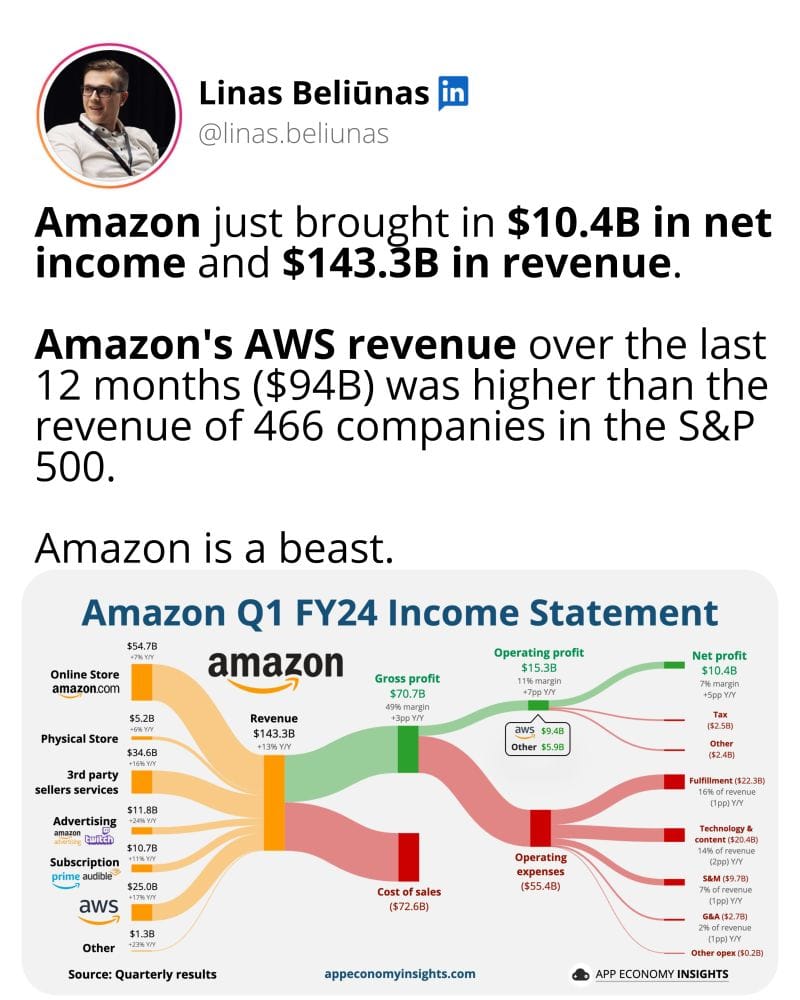How the Mighty Might Fall Mightily
At one point (~1969) Sears was the largest retailer in the world and about 1% of the USA's economy. But, then their innovation slowed down and the levels of innovation of their competitors increased.
Don't misunderstand the words "too big to fail".
According to Cornell Law School, “Too big to fail” refers to an entity so important to a financial system that a government would not allow it to go bankrupt due to the seriousness of the economic repercussions.
Well, yes, government may not allow your demise, but your competitors certainly will. And governments will allow them to obliterate you if they then provide real alternatives to the economy.
That is, to an extent, what is happening to Eskom here in good old SA, isn't it? Households and businesses are doing Eskom's work now by generating their own electricity. From having been Eskom customers, many of us are now effectively Eskom competitors.
Let's look at the story of the fall of American retail colossus Sears and their failure.
Amazon
It is July 16, 1995.
A new small company called Amazon just started trading as an online bookseller.
The Environment at that Time
Online trading was almost non-existent then - and especially here in South Africa.
Households could only access the web through 300-2400 baud dial-up modems that used the existing fixed-line Telkom telephone connections.
Billing depended on the duration of the phone calls to your Internet Service Providers (ISPs). And the first South African ISP, Chris Pinkam's Internet Africa, was launched only 2 years earlier. So, these web-interactions were thus nasty, brutish and short and a far cry from the many hours a day that most of us now spend online.
Carriers? Vodacom was about a year old and it was still a Telkom subsidiary. Telkom, in turn, was only 4 years old, with telephony previously having been a Post Office function.
Access and Devices? The most common mobile phones (and only a few people owned one) were large Nokia 'bricks'. The iPhone was still 12 years into the future and Windows 95 was released one month after Amazon's launch.
E-tailers? On the SA web-commercial side it was still 3 years to the founding of kalahari.com, 4 years to bidorbuy.com (and NetFlorist), and about 12 years to Yuppiechef.
So, yes, the full potential of digital commerce was very far from clear, but Amazon took that leap of faith.
Leading Concepts
Two years later, during 1997, this writer was the Head of IT for a (short-lived) company called Leading Concepts, which was part of the SRG group (with Truworths and Topics), which, in turn, was part of the Wooltru group with Woolworths, Massmart and others.
Leading Concepts was primarily a mail-order business selling mostly what could be called 'gadgets'. So, we had a look at this e-commerce 'thing' and we put up a web-site "just to see" without much hope. But we did so by trying to do it right.
This "do it right" was about making the web-ordering easier and faster than the mail-order process; i.e. saving our customers time and effort if they used the site.
The results, although small in today's terms, astounded us. We immediately started selling way more than our most optimistic projections predicted.
Then, only a month or two later (late December 1997), SRG sold Leading Concepts and we were all retrenched.
Sears
Across the Atlantic Ocean in the USA, a few short years earlier, a company called Sears was (inter alia) the mail-order gorilla. They had all of the infrastructure, such as warehouses and logistics, in place to deliver to customers at their homes. I.e., they already did 'all of that' and they also had the name recognition and public trust. The only difference was that their catalog orders arrived through the mail, as opposed to arriving electronically.
E-commerce, to Sears, was a no-brainer really; they were in the same situation that Leading Concepts was in.
Yet, the Sears COO, Arthur Martinez, thought that the internet was a passing fad. Sears then discontinued its mail-order catalog in 1993, providing the reason that most of their customers were only a short drive away from Sears' stores.
Fear and Hubris in Chicago
In 1973, when Sears was a corporate behemoth, their 'conceit' had them build the Sears Tower (now called the Willis Tower), in Chicago, Illinois. This building was then the tallest skyscraper in the world until the Petronas Towers and the Taipei 101 surpassed it.
Missing the boat on e-commerce was not the only Sears mistake. They also had no answers to Walmart's many innovations (such as in discount retailing, barcodes at POS, shelf-label scanning, their supply chain approaches, etc.).
At one point (~1969) Sears was the largest retailer in the world and about 1% of the USA's economy. They kept innovating throughout the 1970s and early 1980s. But, then their innovation slowed down and the levels of innovation of their competitors increased.
The Corporate Conundrum
Well, yes, Sears could have been right about the internet business being a fad. Goodness knows, we regularly see enough fads come and go.
Right now senior people in corporate environments have to make calls on generative AI, and just recently (and it is actually still the case) calls had to be made on blockchain, bitcoin, stable coins, Web 2.0 or 3.0, the metaverse and many more innovations, inventions and possible opportunities.
This stuff is not easy. If we decide to ignore the changes, we may miss the boat - as Sears did. They then allowed Walmart and Amazon to eat their lunch. But, conversely, if we do decide to invest in the opportunities that new technologies provide, and those turn out to be fads, we may waste money and resources.
To do, or not to do? That is the question.
Charles M. Schulz, creator of the iconic comic strip Peanuts probably summed it up best: “I have a feeling that when my ship comes in I’ll be at the airport.”
So, how now brown cow?
What does one do?
The Answers
There is at least one set of answers to this decision-making conundrum; a set of answers that we promote, namely our Outperformance playbook, contained in our book, and briefly condensed (here) as follows:
Firstly, don't be like Sears (points 1, 2 and 5):
- Do not ignore the changes. Note of all of the changes that may affect you. Don't succumb to hubris. Don't think that you are too big to fail. Don't succumb to fear; the fear of failure and the fear of further innovation - suffering the slings and arrow of outrageous fortune.
- Remember prof. Christensen's Rule number 3: "Markets That Don’t Exist Can’t Be Analyzed". Yes, demand-data and proposition-information for the new options do not yet exist. But, that's fine. Your actions can create that data and your strategy can define that right approach. You don't need to know what the future will look like if you can shape the future and create the future.
- Start from a customer-first perspective. What is the customer proposition and why would that interest them? If not, and you will fall into the 'how-can-we-make-more-money' trap which customers may then ignore or reject.
- Start from a problem-looking-for-a-solution perspective, rather than a solution-looking-for-a-problem perspective. What do your customers need and how do these new options help you to provide that to them?
- Identify these 'problems' in the context of your well-constructed strategy. If, for example, part of your strategy is to reduce customer friction, then figure out if/how these new options can help make that happen.
- Understand that the level of uncertainty does not allow you to do this work as BAU work and nor does it allow you to build proper business cases for Projects. This creation has to be though a venture-building approach.
- Build a minimum-viable-customer-proposition product or service. This product or service must solve at least one customer problem, irrespective of where that problem lives on Maslow's hierarchy of needs. Take arms against these seas of troubles and by opposing, end them.
- If customers then adopt it, build this out further through an iterative and pivoting approach. Let the customer responses drive priorities.
- Fund this in a venture-funding manner; i.e. seeding rounds and series rounds based on the successes and the progress.
- Ensure that your processes are hyper-agile and that you continuously (daily and hourly, not weekly or monthly) deliver new features, fixes, tweaks, offerings, propositions and improvements.
Back to Amazon
So, how did that small book-selling company, that opened its (virtual) doors in July 1995, do in that 'fad' economy that Sears decided is not worth pursuing?
Below are their most recent results. (The image contains the credit sources.).
It is also worth noting that the AWS 'monster', highlighted in this image, was originally built by Chris Pinkham (mentioned above), Willem van Biljon and a team of South Africans.

Finally ...
In 2005, singer-songwriter Sufjan Stevens' album "Illinois" dealt with events and stories related to this American state and to the city of Chicago.
One of the songs on that album is "The Seer's Tower". The lyrics of this song could be about the Tower of Babel, or could also be allusions to Joseph Smith (the Seer) -founder of the LDS (Mormon) church.
Yet, these lyrics probably point to the folly of Sears and the towering building from where they could observe all possible threats (yet, did not manage to do so) and their inevitable(?) eventual decline.
In the tower above the earth
There is a view that reaches far
Where we see the universe
I see the fire, I see the end.

